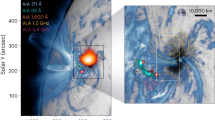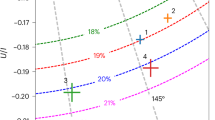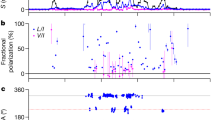Abstract
Pulsars radiate radio signals when they rotate. However, some old pulsars often stop radiating for some periods. The underlying mechanism remains unknown, as the magnetosphere during nulling phases is hard to probe due to the absence of emission measurements. Here we report the detection and accurate polarization measurements of sporadic, weak, narrow dwarf pulses detected in the ordinary nulling state of pulsar B2111+46 via the Five-Hundred-Meter Aperture Spherical radio Telescope. Further analysis shows that their polarization angles follow the average polarization angle curve of normal pulses, suggesting no change of the magnetic-field structure in the emission region in the two emission states. Whereas radio emission of normal individual pulses is radiated by a ‘thunderstorm’ of particles produced by copious discharges in regularly formed gaps, dwarf pulses are produced by one or a few ‘raindrops’ of particles generated by pair production in a fragile gap of this near-death pulsar.
This is a preview of subscription content, access via your institution
Access options
Access Nature and 54 other Nature Portfolio journals
Get Nature+, our best-value online-access subscription
$29.99 / 30 days
cancel any time
Subscribe to this journal
Receive 12 digital issues and online access to articles
$119.00 per year
only $9.92 per issue
Buy this article
- Purchase on Springer Link
- Instant access to full article PDF
Prices may be subject to local taxes which are calculated during checkout





Similar content being viewed by others
Data availability
Original FAST observational data are open source after the one-year protection for the high-priority usage by observers, according to the FAST data policy. The processed data presented in this paper can be download from http://zmtt.bao.ac.cn/GPPS/B2111/.
References
Manchester, R. N. The shape of pulsar beams. J. Astrophys. Astron. 16, 107–117 (1995).
Radhakrishnan, V. & Cooke, D. J. Magnetic poles and the polarization structure of pulsar radiation. Astrophys. Lett. 3, 225 (1969).
Ruderman, M. A. & Sutherland, P. G. Theory of pulsars: polar gaps, sparks, and coherent microwave radiation. Astrophys. J. 196, 51–72 (1975).
Oswald, L., Karastergiou, A. & Johnston, S. Pulsar polarimetry with the Parkes ultra-wideband receiver. Mon. Not. R. Astron. Soc. 496, 1418–1429 (2020).
Backer, D. C. Pulsar nulling phenomena. Nature 228, 42–43 (1970).
Ritchings, R. T. Pulsar single pulse intensity measurements and pulse nulling. Mon. Not. R. Astron. Soc. 176, 249–263 (1976).
Sturrock, P. A. A model of pulsars. Astrophys. J. 164, 529 (1971).
Philippov, A., Timokhin, A. & Spitkovsky, A. Origin of pulsar radio emission. Phys. Rev. Lett. 124, 245101 (2020).
Chen, A. Y., Cruz, F. & Spitkovsky, A. Filling the magnetospheres of weak pulsars. Astrophys. J. 889, 69 (2020).
Cruz, F., Grismayer, T., Chen, A. Y., Spitkovsky, A. & Silva, L. O. Coherent emission from QED cascades in pulsar polar caps. Astrophys. J. Lett. 919, L4 (2021).
Bransgrove, A., Beloborodov, A. M. & Levin, Y. Radio emission and electric gaps in pulsar magnetospheres. Preprint at https://arxiv.org/abs/2209.11362 (2022).
Kramer, M., Lyne, A. G., O’Brien, J. T., Jordan, C. A. & Lorimer, D. R. A periodically active pulsar giving insight into magnetospheric physics. Science 312, 549–551 (2006).
Lorimer, D. R. et al. Radio and X-ray observations of the intermittent pulsar J1832+0029. Astrophys. J. 758, 141 (2012).
Camilo, F., Ransom, S. M., Chatterjee, S., Johnston, S. & Demorest, P. PSR J1841−0500: a radio pulsar that mostly is not there. Astrophys. J. 746, 63 (2012).
Hobbs, G., Lyne, A. G., Kramer, M., Martin, C. E. & Jordan, C. Long-term timing observations of 374 pulsars. Mon. Not. R. Astron. Soc. 353, 1311–1344 (2004).
Davies, J. G. & Large, M. I. A single-pulse search for pulsars. Mon. Not. R. Astron. Soc. 149, 301 (1970).
Mitra, D. & Li, X. H. Comparing geometrical and delay radio emission heights in pulsars. Astron. Astrophys. 421, 215–228 (2004).
Zhang, H., Qiao, G. J., Han, J. L., Lee, K. J. & Wang, H. G. PSR B2111+46: a test of the inverse Compton scattering model of radio emission. Astron. Astrophys. 465, 525–531 (2007).
Thomas, R. M. C. & Gangadhara, R. T. Absolute emission altitude of pulsars: PSRs B1839+09, B1916+14, and B2111+46. Astron. Astrophys. 515, A86 (2010).
Gajjar, V., Joshi, B. C. & Kramer, M. A survey of nulling pulsars using the Giant Meterwave Radio Telescope. Mon. Not. R. Astron. Soc. 424, 1197–1205 (2012).
Han, J. L. et al. The FAST Galactic Plane Pulsar Snapshot survey: I. Project design and pulsar discoveries. Res. Astron. Astrophys. 21, 107 (2021).
Young, N. J., Weltevrede, P., Stappers, B. W., Lyne, A. G. & Kramer, M. On the apparent nulls and extreme variability of PSR J1107−5907. Mon. Not. R. Astron. Soc. 442, 2519–2533 (2014).
Burke-Spolaor, S. et al. The high time resolution universe pulsar survey—V. Single-pulse energetics and modulation properties of 315 pulsars. Mon. Not. R. Astron. Soc. 423, 1351–1367 (2012).
Cognard, I., Shrauner, J. A., Taylor, J. H. & Thorsett, S. E. Giant radio pulses from a millisecond pulsar. Astrophys. J. Lett. 457, L81 (1996).
Rickett, B. J., Hankins, T. H. & Cordes, J. M. The radio spectrum of micropulses from pulsar PSR 0950+08. Astrophys. J. 201, 425–430 (1975).
Soglasnov, V. A. et al. Giant pulses from PSR B1937+21 with widths <=15 nanoseconds and Tb >= 5 × 1039 K, the highest brightness temperature observed in the Universe. Astrophys. J. 616, 439–451 (2004).
Cheng, A. F. & Ruderman, M. A. A theory of subpulse polarization patterns from radio pulsars. Astrophys. J. 229, 348–360 (1979).
Wang, C., Lai, D. & Han, J. Polarization changes of pulsars due to wave propagation through magnetospheres. Mon. Not. R. Astron. Soc. 403, 569–588 (2010).
Beskin, V. S. & Philippov, A. A. On the mean profiles of radio pulsars—I. Theory of propagation effects. Mon. Not. R. Astron. Soc. 425, 814–840 (2012).
Srostlik, Z. & Rankin, J. M. Core and conal component analysis of pulsar B1237+25. Mon. Not. R. Astron. Soc. 362, 1121–1133 (2005).
Young, N. J., Weltevrede, P., Stappers, B. W., Lyne, A. G. & Kramer, M. Long-term observations of three nulling pulsars. Mon. Not. R. Astron. Soc. 449, 1495–1504 (2015).
Manchester, R. N., Hobbs, G. B., Teoh, A. & Hobbs, M. The Australia Telescope National Facility Pulsar Catalogue. Astron. J. 129, 1993–2006 (2005).
van Straten, W. & Bailes, M. DSPSR: Digital signal processing software for pulsar astronomy. Publ. Astron. Soc. Aust. 28, 1–14 (2011).
Wang, P. F. et al. FAST pulsar database: I. polarization profiles of 682 pulsars. Res. Astron. Astrophys. 23, 104002 (2023).
Hotan, A. W., van Straten, W. & Manchester, R. N. Psrchive and psrfits: an open approach to radio pulsar data storage and analysis. Publ. Astron. Soc. Aust. 21, 302–309 (2004).
Force, M. M., Demorest, P. & Rankin, J. M. Absolute polarization determinations of 33 pulsars using the Green Bank Telescope. Mon. Not. R. Astron. Soc. 453, 4485–4499 (2015).
Lyne, A. G. & Manchester, R. N. The shape of pulsar radio beams. Mon. Not. R. Astron. Soc. 234, 477–508 (1988).
Gould, D. M. & Lyne, A. G. Multifrequency polarimetry of 300 radio pulsars. Mon. Not. R. Astron. Soc. 301, 235–260 (1998).
Force, M. M., Demorest, P. & Rankin, J. M. Absolute polarization determinations of 33 pulsars using the Green Bank Telescope. Mon. Not. R. Astron. Soc. 453, 4485–4499 (2015).
Rankin, J. M. Toward an empirical theory of pulsar emission. VI. The geometry of the conal emission region. Astrophys. J. 405, 285 (1993).
Radhakrishnan, V. & Rankin, J. M. Toward an empirical theory of pulsar emission. V. On the circular polarization in pulsar radiation. Astrophys. J. 352, 258 (1990).
Han, J. L., Manchester, R. N., Xu, R. X. & Qiao, G. J. Circular polarization in pulsar integrated profiles. Mon. Not. R. Astron. Soc. 300, 373–387 (1998).
Gangadhara, R. T., Han, J. L. & Wang, P. F. Coherent curvature radio emission and polarization from pulsars. Astrophys. J. 911, 152 (2021).
Zhang, B., Harding, A. K. & Muslimov, A. G. Radio pulsar death line revisited: is PSR J2144−3933 anomalous? Astrophys. J. Lett. 531, L135–L138 (2000).
Chen, K. & Ruderman, M. Pulsar death lines and death valley. Astrophys. J. 402, 264 (1993).
Weltevrede, P., Wright, G. A. E., Stappers, B. W. & Rankin, J. M. The bright spiky emission of pulsar B0656+14. Astron. Astrophys. 458, 269–283 (2006).
Burke-Spolaor, S. & Bailes, M. The millisecond radio sky: transients from a blind single-pulse search. Mon. Not. R. Astron. Soc. 402, 855–866 (2010).
Esamdin, A., Abdurixit, D., Manchester, R. N. & Niu, H. B. PSR B0826−34: sometimes a rotating radio transient. Astrophys. J. Lett. 759, L3 (2012).
Goldreich, P. & Julian, W. H. Pulsar electrodynamics. Astrophys. J. 157, 869 (1969).
Arons, J. & Scharlemann, E. T. Pair formation above pulsar polar caps: structure of the low altitude acceleration zone. Astrophys. J. 231, 854–879 (1979).
Cheng, K. S., Ho, C. & Ruderman, M. Energetic radiation from rapidly spinning pulsars. I. Outer magnetosphere gaps. Astrophys. J. 300, 500 (1986).
Qiao, G. J., Lee, K. J., Wang, H. G., Xu, R. X. & Han, J. L. The inner annular gap for pulsar radiation: γ-ray and radio emission. Astrophys. J. Lett. 606, L49–L52 (2004).
Muslimov, A. G. & Harding, A. K. High-altitude particle acceleration and radiation in pulsar slot gaps. Astrophys. J. 606, 1143–1153 (2004).
Acknowledgements
This work made use of data from FAST. FAST is a Chinese national mega-science facility, built and operated by the National Astronomical Observatories, Chinese Academy of Sciences. The authors of this work have been supported by the Natural Science Foundation of China: numbers 11988101 and 11833009 and National SKA Program of China 2020SKA0120100.
Author information
Authors and Affiliations
Contributions
X.C. and Y.Y. processed all related data and noticed the dwarf pulses, and they contributed to this paper equally. J.L.H. supervised and coordinated the team work, pursued the nature of the dwarf pulses and took the responsibility for paper writing. P.F.W., C.W., W.C.J. and D.J.Z. contributed to different aspects of data processing. T.W., W.Y.W., Z.L.Y., W.Q.S., N.N.C., J.X., R.X.X., K.J.L., G.J.Q. and B.Z. joined the discussions and contributed to some parts of paper writing or plot-making.
Corresponding author
Ethics declarations
Competing interests
The authors declare no competing interests.
Peer review
Peer review information
Nature Astronomy thanks Ashley Bransgrove and the other, anonymous, reviewer(s) for their contribution to the peer review of this work.
Additional information
Publisher’s note Springer Nature remains neutral with regard to jurisdictional claims in published maps and institutional affiliations.
Extended data
Extended Data Fig. 1 The pulses of PSR B2111+46 observed by FAST in the session on 2020-08-24.
The left-most panel is the train of individual pulses for 886 periods, with the mean profile shown in the bottom and the intensity of which is normalized using the peak value. The total energy of every individual pulse is plotted in the immediately right, so that the energy fluctuations are seen very clearly which show the two predominate peaks for both nulling and emission states in the number distributions in the bottom. A segment of the pulse stack is shown in grey for high quality individual pulses, with significant fluctuations of profile amplitude, in which normal individual pulses can be seen in the period No. 702-700, 696 and 680, partial nulling in the period No. 679, and dwarf pulses of the period No. 699 and 682. The detailed polarization profiles for 4 pulses are presented in the right 4 panels, each with total intensity I, linear polarization L and circular polarization V in the bottom subpanel and P A in the upper subpanel. The polarization profiles of the mean pulse are shown in dashed line in these subpanels for comparison. The error bar for PA is ± 1σ.
Extended Data Fig. 2 The pulses of PSR B2111+46 observed by FAST in the session on 2020-08-26.
The left-most panel is the train of individual pulses for 886 periods, with the mean profile shown in the bottom and the intensity of which is normalized using the peak value. The total energy of every individual pulse is plotted in the immediately right. A segment of the pulse stack is shown in grey for high quality individual pulses, with a dwarf pulse in the period No. 377 and partial nulling in the period No. 365. The detailed polarization profiles for 4 pulses are presented in the right 4 panels, each with total intensity I, linear polarization L and circular polarization V in the bottom subpanel and P A in the upper subpanel. The polarization profiles of the mean pulse are shown in dashed line in these subpanels for comparison. The error bar for PA is ± 1σ.
Extended Data Fig. 3 The pulses of PSR B2111+46 observed by FAST in the session on 2020-09-17.
The left-most panel is the train of individual pulses for 885 periods, with the mean profile shown in the bottom and the intensity of which is normalized using the peak value. The total energy of every individual pulse is plotted in the immediately right. A segment of the pulse stack is shown in grey for high quality individual pulses, with a dwarf pulse in the period No. 136 and partial nulling in the period No. 137. The detailed polarization profiles for 4 pulses are presented in the right 4 panels, each with total intensity I, linear polarization L and circular polarization V in the bottom subpanel and P A in the upper subpanel. The polarization profiles of the mean pulse are shown in dashed line in these subpanels for comparison. The error bar for PA is ± 1σ.
Extended Data Fig. 4 The pulses of PSR B2111+46 observed by FAST in the session on on 2022-03-08.
The left-most panel is the train of individual pulses for 7098 periods, with the mean profile shown in the bottom and the intensity of which is normalized using the peak value. The total energy of every individual pulse is plotted in the immediately right. A segment of the pulse stack is shown in grey for high quality individual pulses, with a dwarf pulse in period of No.5895 and two partial nullings in the period No. 5891 and 5897. The detailed polarization profiles for 4 pulses are presented in the right 4 panels, each with total intensity I, linear polarization L and circularpolarization V in the bottom subpanel and P A in the upper subpanel. The polarization profiles of the mean pulse are shown in dashed line in these subpanels for comparison. The error bar for PA is ± 1σ.
Extended Data Fig. 5 Examples of polarization profiles for two dwarf pulses and two strong individual pulses in high time resolution.
All of them are observed on 2022-03-08 by FAST with time resolution of 49.152 μs. Polarization profiles for two strong individual pulses are shown for their elongated central part in the next panel. Each rip in the profiles is real, well-significant above the noise fluctuations. These unrepresented details indicate that the observed individual pulses are an incoherent collection of many elementary pulses generated separately in the magnetosphere. The error bar for PA is ± 1σ. The intensity is scaled with the off-pulse fluctuations expressed by σbin.
Extended Data Fig. 6 Longitude distribution of dwarf pulses.
Longitude distribution of dwarf pulse locations are compared to the mean pulse profile indicated by the dash line. The bar length stands for dwarf pulse width, and the dots mark the peak locations in the longitude.
Extended Data Fig. 7 Pulsar period and period derivative (\({{{\rm{P}}}}-\dot{{{{\rm{P}}}}}\)) diagram and the location of PSR B2111+46 in the death valley.
The death lines are given for the curvature radiation in a dipole field (upper one) and an extremely curved field (lower one) in the vacuum gap model (sold lines) and the space- charged-limited flow model (dashed lines) given in44. All pulsar data are taken from the ATNF pulsar Catalogue32 (version 1.70). The background gray dashed and dotted lines stand for constant surface magnetic field strengths and characteristic ages, respectively.
Extended Data Fig. 8 Distributions for spectral indexes of three kinds of individual pulses.
All these pulses, including 5175 normal pulses, 199 partial nulling pulses and 67 dwarf pulses, are observed by FAST on 2022-03-08. The indexes are calculated for each individual pulse by using the on-pulse integrated intensity, and have an uncertainty less than 0.5.
Extended Data Fig. 9 The number distribution of phase-resolved spectral indexes.
Data of spectral indexes of all phase bins have an uncertainty less than 0.5 for all individual pulses observed by FAST on 2022-03-08, as shown in the upper subpanel, together with the mean polarization profile for understanding in the lower subpanel scaled with the peak value.
Extended Data Fig. 10 The phase shift distribution of polarization angles of 62 dwarf pulses.
The shift values are obtained by comparison of their PA to the mean PA curve at the longitude of dwarf pulses.
Rights and permissions
Springer Nature or its licensor (e.g. a society or other partner) holds exclusive rights to this article under a publishing agreement with the author(s) or other rightsholder(s); author self-archiving of the accepted manuscript version of this article is solely governed by the terms of such publishing agreement and applicable law.
About this article
Cite this article
Chen, X., Yan, Y., Han, J.L. et al. Strong and weak pulsar radio emission due to thunderstorms and raindrops of particles in the magnetosphere. Nat Astron 7, 1235–1244 (2023). https://doi.org/10.1038/s41550-023-02056-z
Received:
Accepted:
Published:
Issue Date:
DOI: https://doi.org/10.1038/s41550-023-02056-z
This article is cited by
-
Investigation of states switch properties of PSR J1946 + 1805 with the FAST
Astrophysics and Space Science (2024)



